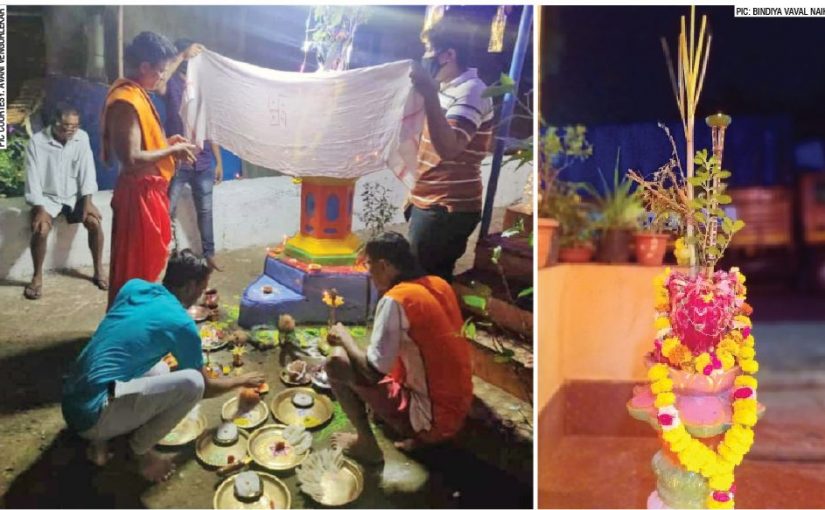TULSI VIVAH puja in celebration of enduring love to do with Hinduism’s Lord Vishnu and Tulsi in hoary times gone by (it’s a complicated story). Many Goan families get together to perform this puja on any day from Kaarthik Dwadashi (12th day of the bright fortnight of the month of Kaarthik till poornima, full moon night); with the Tulsi Vivah puja Hindus say au revoir to the monsoon rains and usher in the marriage season. Picture depicts Tulsi Vivah puja under way; an ornamental vrindavan with a tulsi plant growing in it for daily worship and especially during Tulsi Vivah…it is ritually garlanded with marigold flowers along with a bundle comprising of gino stick, sugarcane cuttings, Indian gooseberry (aonla), tamarind leaves with fruit, mango leaves.
By Pankajbala R Patel
ON THURSDAY morning (i.e. November 26) the Panaji market was swarming with men buying all that was required for the celebration of one of Goa’s most charming and Hinduism’s most intriguing celebrations – in Goa Tulsi Vivah is also described as Vhodli Divali, when the sacred plant of the tulsi or basil is ceremoniously married to Lord Vishnu. Read up Hindu mythology and one will find any number of stories to do with the plant tulsi which in hoary religious legend was much loved by Lord Vishnu.
It is a fact that on the occasion of Tulsi Vivah a puja is performed by married women who pray for marital bliss. From the sound of it women need to fear the tulsi plant which in mythology recounts several stories, one of them to do with how an angry great sage Bhrigu had cursed Lord Vishnu for all the women he killed…we may not go by the superficial aspects of these stories however! Lord Vishnu’s wives were Lakshmi, Saraswati and Ganga but as it goes in our Hindu mythology stories weave into one another to offer endless food for thought. Tulsi reportedly was one of the demon Jalandhar’s consorts and for some reason the leaves of the tulsi plant are considered a favorite of Lord Krishna too (Lord Vishnu latter day avatar) and in our temples garlands of leafy green Vishu tulsi garlands are offered to Lord Krishna idols…Goan folk songs do immortalize the stories of Tulsi Vivah I’m told and most celebrations and performances take place in the space called “maand” in the courtyard where the family tulsi vrindavan is sited, here the Tulsi Vivah puja is also performed and celebrated…
And afterwards the day’s feasting will include half-a-dozen dishes made of parched rice white and red, sweet and savory, in coconut milk or dairy milk…sweetened further by palm jaggery, raisins, whatever else goes into making pleasing flavors for the palate and fit for the gods and goddesses of the Hindu pantheon. I remember when Digambar Kamat was chief minister of Goa he had his wife Asha Kamat put up a veritable feast of Tulsi Vivah preparations which included all the fov recipes and more!
But to return to the celebration of Tulsi Vivah in Goa. At the Panaji market I saw mostly men and a few women buying these bundles of lush green stuff for maybe 50 and100 and `150 depending on what was packed up for the Tulsi Vivah puja – there must be mango sugar cane sticks of course, mango leaves, tamarind and tamarind leaves, aonla or Indian gooseberries stalks, ambade or hogplums, sheaves of rice plant maybe, there will always be a stick of the gino plant which reportedly represents the husband), etcetera.
Goans take their Tulsi Vivah puja seriously and it’s quite an occasion when women meet up to compare notes on how Tulsi puja concludes the Chaturmaas months of the monsoon and heralds the Hindu marriage season and the various alliances coming up for better or for worse, hopefully for the better of course! With the Tulsi Vivah puja the marriatge season is all set to roll religiously, traditionally, culturally and socially speaking.
Since for all kinds of fascinating reasons the plant of the tulsi is most sacred to Hindus (since the beginning of the religion maybe or somewhere along the way over generations of story-telling in the Ramayana and Mahabharat), you may have noticed that most Hindu household courtyards to this day will sport a tulsi vrindavan (also brindaban) – the plain or ornamental terracot pots of various sizes in which the tulsi plant is planted and ritually worshiped morning and evening. I’ve noticed that you will never find a tulsi vrindavan indoors, the tulsi plant enjoys a much revered feminine persona and is always worshipped out in the great or small outdoors.

The tulsi plant grows with abundance in the tropical climate of Goa and there’re various varieties too from the primary Vishnu tulsi (green leaves) to Shyam tulsi (a hardier variety offering purplish green leaves and apparently dear to Lord Krishna); there are other varieties too for the basil family is a veritable joint family of fragrant plants!
Needless to say tulsi leaves feature in most prasad distributed be it as a garnish on sweet semolina halva or added with a piece of coconut piece, gud (jaggery nugget) and roasted gram. It’s the times immemorial prasad given to all freely when they worship at temple or at the home shrine.
To say the least here the celebration of Tulsi Vivah is one of the most charming of celebrations in Goa when families meet and exchange each other’s woes and blessings and how to plan the new year ahead of them. May all curses end and blessings come showering down!
